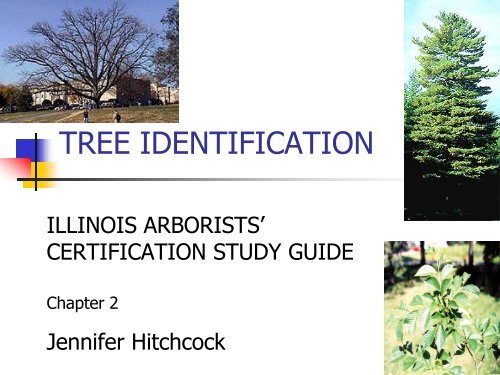Chapter 2: Tree Identification - Illinois Arborist Association
Chapter 2: Tree Identification - Illinois Arborist Association
Chapter 2: Tree Identification - Illinois Arborist Association
Create successful ePaper yourself
Turn your PDF publications into a flip-book with our unique Google optimized e-Paper software.
TREE IDENTIFICATION<br />
ILLINOIS ARBORISTS‟<br />
CERTIFICATION STUDY GUIDE<br />
<strong>Chapter</strong> 2<br />
Jennifer Hitchcock
TAXONOMY OR PLANT<br />
CLASSIFICATION<br />
Based on similar biological<br />
characteristics<br />
Kingdom<br />
Division or Phylum (vascular and<br />
nonvascular plants)<br />
Angiosperms and gymnosperms<br />
Class (monocots and dicots)<br />
Orders, Families, Genus, Species (Table 2.1)
ANGIOSPERMS<br />
(Flowering Plants)<br />
Seeds covered by an ovary<br />
Deciduous trees<br />
Broadleaved evergreens<br />
Classes of angiosperms<br />
Dicots – two cotyledons or seed leaves<br />
Monocots – one cotyledon or seed leaf
GYMNOSPERMS<br />
(Cone-bearing Plants)<br />
“Naked” seeds<br />
Conifers or cone-bearing<br />
plants
COMMON NAMES<br />
Can be confusing and are localized<br />
Carpinus caroliniana may be called<br />
American hornbeam, blue beech,<br />
ironwood, musclewood<br />
Tulip poplar may be Magnolia x<br />
soulangiana, Spathodea campanulata,<br />
and Liriodendron tulipifera
SCIENTIFIC NAMES<br />
Two parts to the name<br />
Pinus nigra<br />
Quercus alba<br />
Acer rubra
PLANT NOMENCLATURE<br />
Variety:<br />
Subdivision of a<br />
species that has a<br />
difference and breeds<br />
true to that<br />
difference
PLANT NOMENCLATURE<br />
Cultivar:<br />
A cultivated variety<br />
Names are written with<br />
single quotes<br />
U. „Morton‟-Accolade TM
PLANT MORPHOLOGY<br />
Woody plant identification is based on<br />
plant morphology<br />
Morphology – the size, shape and<br />
appearance of plant parts
PLANT MORPHOLOGY<br />
Important to identify trees using a<br />
number of features including:<br />
Leaves Buds<br />
Fruit Flowers<br />
Bark Growth form<br />
Texture
Leaf structures<br />
Leaf margin<br />
Leaf base<br />
Trichomes<br />
PRINCIPLES OF<br />
IDENTIFICATION
LEAF MARGINS, TIPS AND<br />
Leaf margins<br />
BASES<br />
Entire Serrate<br />
Dentate Lobed<br />
Leaf tips<br />
Acuminate Acute<br />
Obtuse Truncate<br />
Leaf bases<br />
Rounded<br />
Cordate<br />
Acute
Simple (white oak)<br />
Compound (ash)<br />
Pinnately<br />
compound (locust)<br />
LEAF TYPES
LEAF TYPES<br />
Bi-pinnately<br />
compound<br />
(Kentucky coffee tree)<br />
Palmate (buckeye)
LEAF ARRANGEMENTS<br />
Alternate<br />
(oak, elm)<br />
Opposite<br />
(maple, ash,<br />
dogwood, buckeye)<br />
-MAD Buck/Horse<br />
Whorled (catalpa)
LEAF ARRANGEMENT FOR<br />
CONIFERS<br />
Needles in clusters<br />
of 2,3,5 (pines)<br />
Needles produced<br />
singly<br />
(firs and spruces)
LEAF ARRANGEMENT FOR<br />
CONIFERS<br />
Awl-like or scale-like<br />
(junipers, cedars, and<br />
arborvitae)
BUDS<br />
Narrowly conical Ovoid<br />
Conical Stalked<br />
Scaled Rounded<br />
Valvate
IDENTIFICATION KEYS<br />
Step by step method for identifying<br />
plants<br />
Consist of yes or no questions<br />
Must understand the terms used


